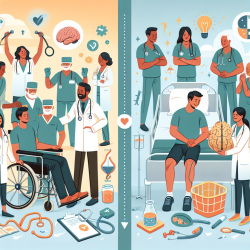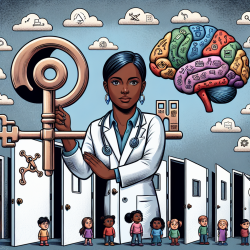Introduction
As a practitioner in the field of speech-language pathology, understanding the latest research and implementing data-driven strategies is crucial for improving patient outcomes. A recent study titled "Early Supported Discharge for Neurorehabilitation Following Acquired Brain Injury" provides valuable insights into how Early Supported Discharge (ESD) can be a viable alternative to traditional inpatient rehabilitation for patients with acquired brain injury (ABI).
Understanding Early Supported Discharge (ESD)
ESD is a clinical service that offers interdisciplinary rehabilitation support at home, rather than in a hospital setting. This approach is designed to emulate the intensive care provided in inpatient rehabilitation (IPR) programs, but in a more familiar and comfortable environment for the patient. The study found that ESD can lead to significant improvements in functional outcomes, reduced caregiver burden, and fewer medical complications compared to traditional IPR.
Key Findings from the Research
- Functional Outcomes: Both ESD and IPR groups showed improvements in functional outcomes, as measured by the Mayo-Portland Adaptability Index-4 (MPAI). However, the ESD group experienced these improvements with fewer medical complications.
- Caregiver Burden: Caregivers in the ESD group reported a significant reduction in perceived burden over time, as measured by the Zarit Burden Interview (ZBI). This suggests that ESD not only benefits patients but also their families and caregivers.
- Medical Complications: The study reported a lower incidence of medical complications in the ESD group compared to the IPR group, highlighting the potential health benefits of in-home rehabilitation.
Implications for Practitioners
For practitioners in the field of neurorehabilitation, these findings underscore the importance of considering ESD as a treatment option for ABI patients. Implementing ESD can lead to improved patient outcomes, reduced caregiver stress, and potentially lower healthcare costs. Practitioners should consider the following steps:
- Evaluate Patient Suitability: Not all patients may be suitable for ESD. Assess each patient's medical stability, rehabilitation needs, and home environment to determine if ESD is appropriate.
- Interdisciplinary Approach: Collaborate with a team of healthcare professionals, including physiotherapists, occupational therapists, and neuropsychologists, to provide comprehensive care tailored to each patient's needs.
- Monitor Progress: Use standardized tools like the MPAI and ZBI to track patient progress and caregiver burden over time, adjusting treatment plans as needed.
Encouraging Further Research
While the study provides promising results, further research is needed to fully understand the long-term benefits and limitations of ESD for ABI patients. A randomized control trial could provide more definitive evidence on the efficacy of ESD compared to traditional IPR. Additionally, exploring the affective and lifestyle elements of ABI recovery could enhance our understanding of targeted neurorehabilitation.
To read the original research paper, please follow this link: Early Supported Discharge for Neurorehabilitation Following Acquired Brain Injury.










